Victorians renewing or applying for a driver’s licence could soon notice a new step in the process: a prompt asking whether they want to join the Australian Organ Donor Register. The change is part of a broad state push to lift donor participation, after Victoria was flagged as having one of the lowest sign-up rates in the country.
Right now, just 23 per cent of Victorians are registered organ donors, and young people make up only a small slice of that figure. Concerned by the gap, the Victorian Government has backed a slate of reforms drawn from a parliamentary inquiry into donation rates, agreeing to adopt all 41 recommendations in full or in part.
A key focus is education before eligibility. Under the plan, 15- and 16-year-olds will be taught about organ donation before they’re old enough to register or apply for a licence. Donation information will also be built into both primary and secondary school curricula, with the idea that awareness should start early, not at the counter on licence day.
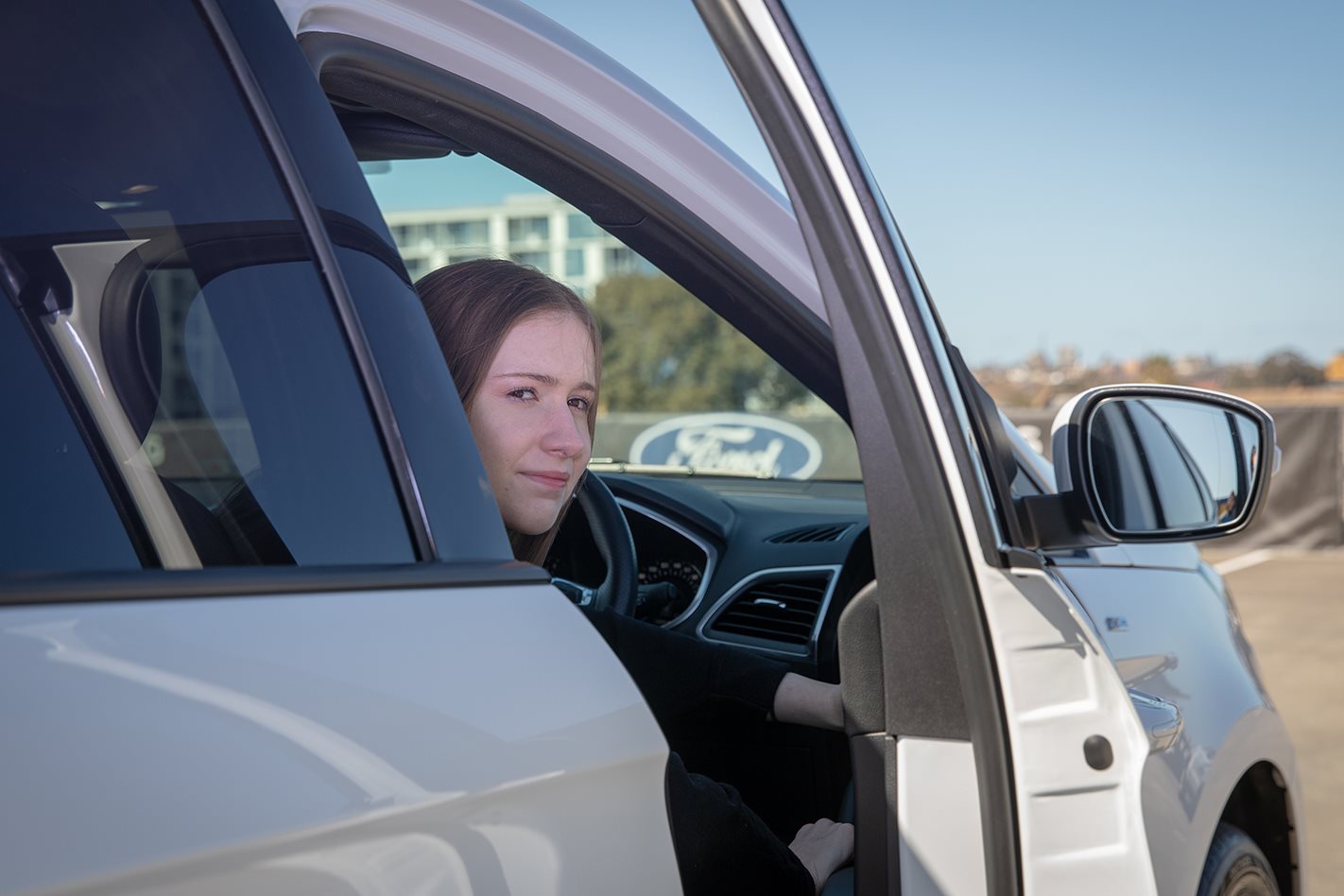
The licence link is not new territory for Victoria. For years, drivers could tick a box indicating they were willing to be an organ donor, and licences were marked “Potential organ donor” beside the photo. But that system was removed in the early 2000s, leaving many people unsure whether their earlier choice still counted. The inquiry found records didn’t always transfer cleanly to the national register, meaning some drivers assumed they were listed when they weren’t. Victorians can confirm their status through Medicare on myGov or via the Medicare app.
South Australia shows why governments are revisiting this approach. It remains the only state or territory where a donation decision can be recorded through a driver’s licence, and its registration rate is the nation’s highest at 72 per cent. The Victorian inquiry cited that contrast as evidence a simple, high-reach sign-up point can shift the numbers quickly.
So what happens next? The state will move to reintroduce organ donor registration into the licence system for new applicants and renewals. A separate online pathway will also be strengthened, including a clear call-to-action button on the Service Victoria website, making it easier to sign up without waiting for a renewal cycle. A major public awareness campaign is planned across TV, radio, outdoor billboards and digital channels.
Schools will play a supporting role, not only encouraging students to register once eligible, but prompting conversations at home. The inquiry stressed that family discussion is crucial: when someone’s wishes are known in advance, it reduces stress for loved ones during grief and makes consent more likely to be honoured.
“Nearly every eligible Victorian holds a driver licence,” the inquiry summary noted, pointing out that the licensing system offers a rare chance to reach almost the entire adult population in one consistent place. In other words, if you want a mass-scale lift in registrations, the licence desk is where you find it.
Alongside organ donation, the reforms also highlight another shortage: stem cell donors. Australia’s low numbers mean about three-quarters of stem cell donations currently come from overseas. The Australian Bone Marrow Donor Registry is particularly seeking more young, male and ethnically diverse donors, and the registration process is described as comparable to signing up to donate blood or plasma.
For those who want to register or learn more, the national organ donor information hub is donatelife.gov.au, while stem cell donor details are available through strengthtogive.org.au.
Kia’s 2025 has already been crammed with fresh metal and forward-looking concepts, but the brand clearly isn’t done yet. A newly teased all-electric four-door sedan concept suggests another reveal is imminent, and it could mark Kia’s return to the executive saloon space after a brief absence.
Kia said goodbye to its last traditional sedan hero, the Stinger, in 2023. This new concept appears to be its philosophical opposite – a low-slung EV with futuristic surfacing – yet it also hints Kia hasn’t abandoned the idea of a flagship four-door for drivers who want something sleeker than an SUV. The company’s social teaser offered little more than a shadowy profile and a line reading, “A new future is on the horizon. Our vision takes shape soon,” but the timing points to a full debut in January.
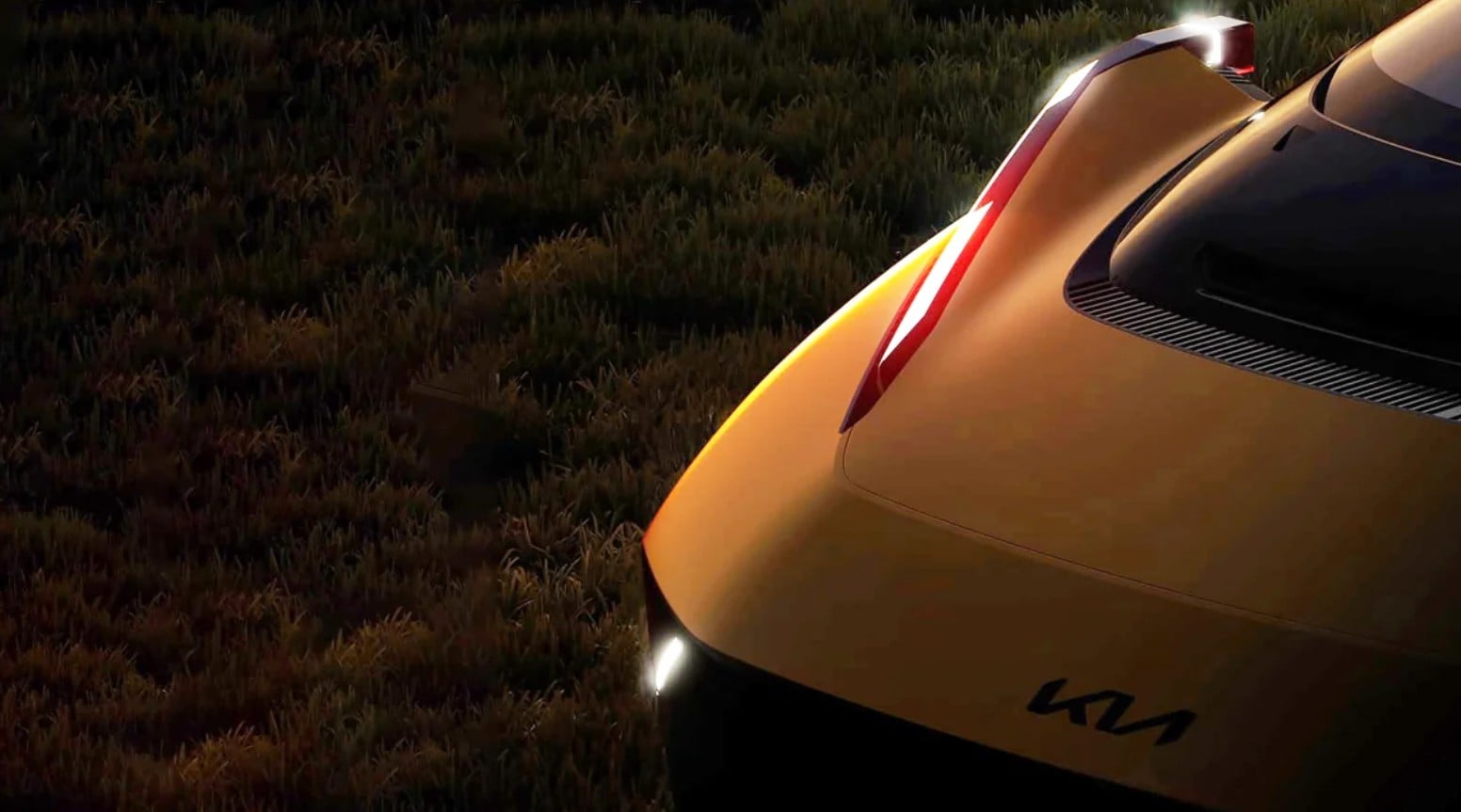
Even in silhouette, the concept wears familiar Kia EV cues. The front lighting appears to use the brand’s “Star Map” signature, with daytime running lights spanning the nose and headlamps positioned unusually high on the bonnet line. At the back, thin horizontal LEDs echo the look of recent products such as the EV3, EV5 and EV9, reinforcing that this car sits within Kia’s “Opposites United” design language rather than breaking away from it.
The body shape is the real headline. Although it’s clearly a four-door sedan, the proportions lean cab-forward, made possible by the absence of a bulky combustion engine under the short bonnet. A steep, panoramic windscreen flows into a long roofline, while frameless side glass and mirror-mounted digital cameras give the car a clean, almost concept-car-pure look. The overall stance is low and slippery – a sign Kia is chasing efficiency and range as much as outright presence.
Inside, the teaser glimpse shows a yoke-style steering wheel, hinting at steer-by-wire technology similar to systems Hyundai has previewed in recent mobility concepts. If that’s the direction Kia takes, it could also enable advanced low-speed manoeuvring tech and potentially rear- or even four-wheel steering for sharper dynamics.
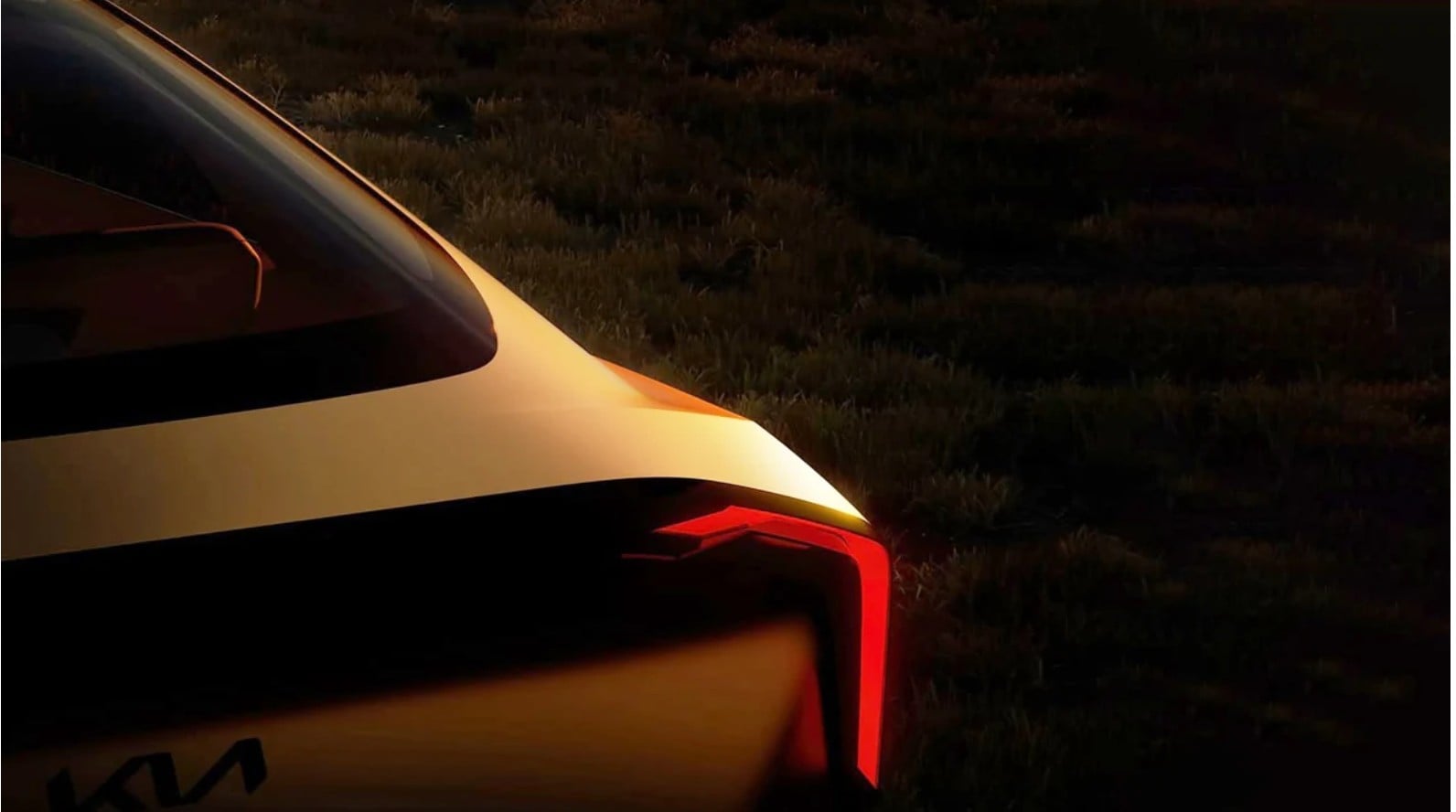
A stretched wheelbase is also evident, which raises the possibility this sedan could be engineered to take Kia’s biggest battery pack – the 99.8kWh unit currently sitting at the top of the EV9 range. If so, the sedan’s sleeker aerodynamics could push driving range well beyond the EV9’s quoted peak of 349 miles (about 562km), giving Kia a genuine long-distance flagship without SUV bulk.
Where might it sit in Kia’s line-up? The brand has already expanded its EV family with models like EV4 and EV5, and the EV3 and EV9 covering smaller and larger SUV territory. That leaves limited space for a fresh nameplate – but the “EV7” and “EV8” badges are still unused, making either a logical fit for a coupe-like sedan positioned above the EV6 and below the EV9.
For now, Kia is keeping the details close, but the message is clear: a sleek electric saloon is back on the agenda – and it may be the spiritual next step after the Stinger, just with batteries instead of a twin-turbo V6.
It’s already one of the world’s most iconic cars, but a new bodystyle is being added to the Mercedes-Benz G-Class: a convertible, and it’s already started testing ahead of a likely debut in 2026.
Set to be available in numerous markets around the world – including, likely, Australia – the G-Class Cabriolet will be based on petrol-powered models (not the electric G 580) and will be limited in number.
What will change for the drop-top G-Class Cabriolet – as evidenced by these official and rather revealing teaser images from Mercedes – is the amount of doors. Mercedes has often sold soft-top G-Class models in the past, but these were typically only available in a short-wheelbase form with two doors. When the current-generation G-Class arrived, only a long-wheelbase variant was offered, so other than a few extravagant Landaulet versions, the model had remained as a hard-top only until now.

It’s clear the new G-Class Cabriolet will get a canvas roof – just like previous models. Also like on the old convertible G-Class, we expect the roof to operate electronically – though getting all the material folded in front of the spare wheel cover might be a task as the canvas canopy stretches all the way over the heads of the front occupants. We can also expect to see some level of reduction in the existing boot and rear seat space to make room for the roof.
In a media statement, Mercedes-Benz said that the “eagerly awaited G‑Class Cabriolet is completing its first test kilometres in Austria with engineers gathering comprehensive data to ensure that the open-top driving experience of the G‑Class Cabriolet is promising an unparalleled and unmistakable G‑Class feeling for future drivers”.
“At a later date, the G‑Class Cabriolet will also make its way to Sweden, where it will be put through demanding winter testing. Facing icy temperatures and snowy landscapes, the newcomer’s robustness, driving dynamics, and reliability will be thoroughly proven.”
Pricing and specifications have been revealed for the Volkswagen Touareg Wolfsburg, which will be available from March 2026. Following other Wolfsburg special editions in the Volkswagen range, the Touareg Wolfsburg adds “styling and luxury enhancements”, according to its maker. Priced from $124,990 plus on-road costs, the Wolfsburg celebrates the final year of Touareg production for the current generation model.
Replacing the Touareg 210TDI R-Line in the Australian lineup, the Wolfsburg includes 21-inch black alloy wheels, an exterior black package with gloss black covering the roof rails, window surrounds, grill, front and rear bumpers, mirror caps and a tailgate-applied Wolfsburg emblem.
Inside, the Touareg Wolfsburg includes a panoramic sunroof, rear outboard heated seats, Dynaudio Consequence sound system, head-up display, four-zone climate control, power door latching, passenger seat memory settings and electric steering column with driver memory setting.
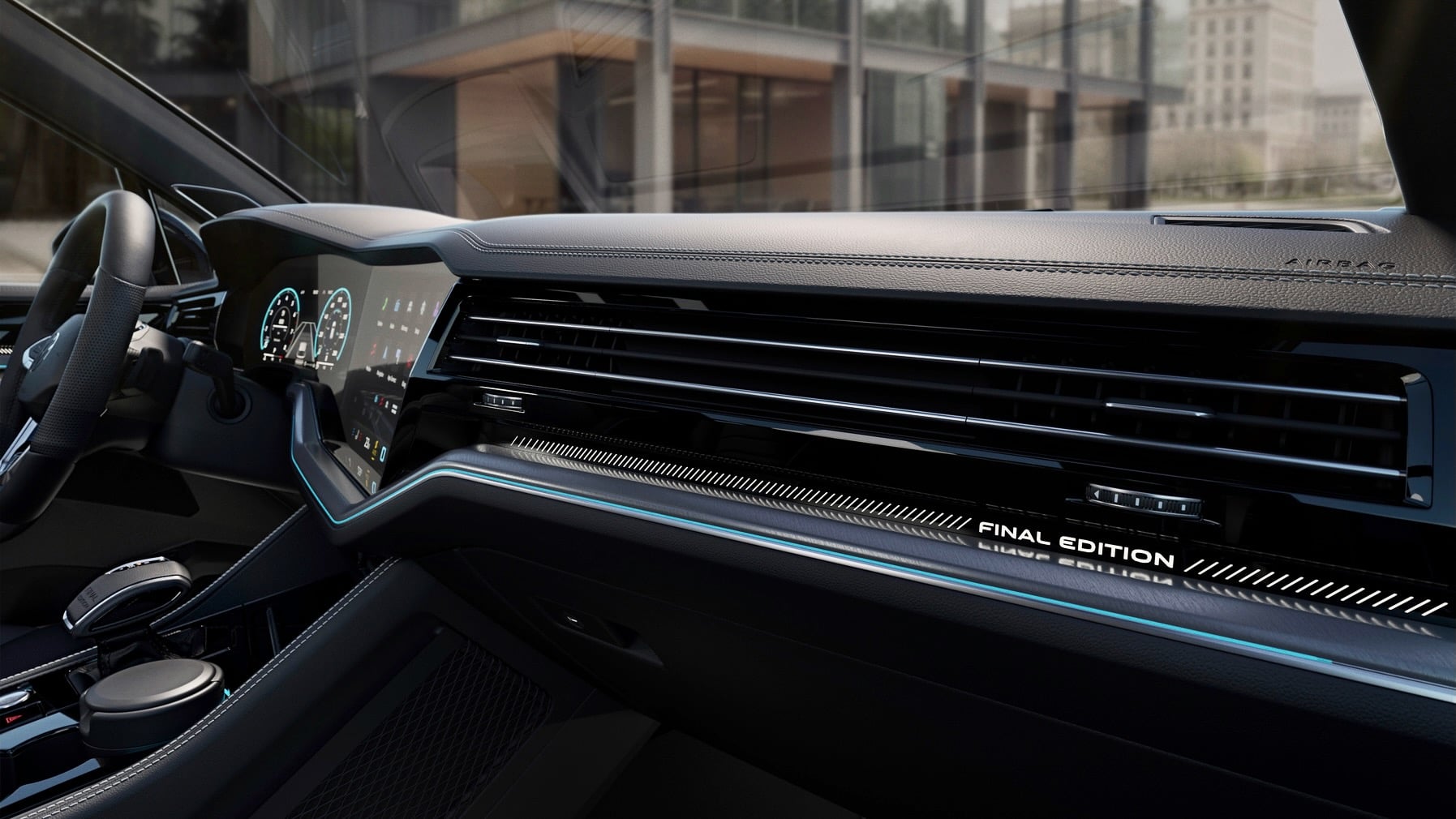
Metallic paint is included, with ‘Silicon Grey’ and and ‘Grenadilla Black’ included. ‘Meloe-Blue’ premium metallic is a $700 option, while ‘Oryx White’ pearlescent – exclusive to the Wolfsburg edition – is a special $2,000 option.
Volkswagen Passenger Vehicles Head of Product Arjun Nidigallu said the Touareg continues to combine an elevated Volkswagen experience with even greater exclusivity towards this generation’s final year of production. “The Touareg 210TDI Wolfsburg Edition places alongside the Touareg R as the heroes of the current generation model, with additional luxury and exclusivity,” Mr Nidigallu said.
2026 Volkswagen Touareg pricing (plus on-road costs):
| 170TDI | $91,960 |
|---|---|
| 210TDI Elegance | $105,990 |
| 210TDI Wolfsburg Edition | $124,990 |
| 340TSI R PHEV | $136,790 |
The Volkswagen Touareg 210TDI Wolfsburg Edition will be available in dealerships nationwide from March 2026.
Hyundai’s excellent IONIQ 5 electric mid-size SUV has been updated for the 2026 model year with a simplified model line-up, an 84kWh battery across the range and added features including phone key functionality. Pricing starts at $76,200 plus on-road costs for the entry-level model, which is $6400 more than before because the smallest battery is no longer available. But the base, Elite and N Line Premium have only increased by $400 compared with their equivalents in the 2025 range.
Like the Santa Fe and Tucson SUVs, the 2026 Hyundai IONIQ 5 line-up now includes the company’s ‘Digital Key 2.0’ functionality, which allows users lock, unlock and start their car through their smartphone’s wallet functionality. Digital Key 2.0 can be shared with up to 15 compatible devices and does not need a mobile network signal to work.
Other changes to the 2026 line-up include a new ‘Celadon Grey Matte’ colour joining the palette, while a black interior has been made standard across the line-up – two lighter options are offered as a no-cost option on the mid-spec Elite.
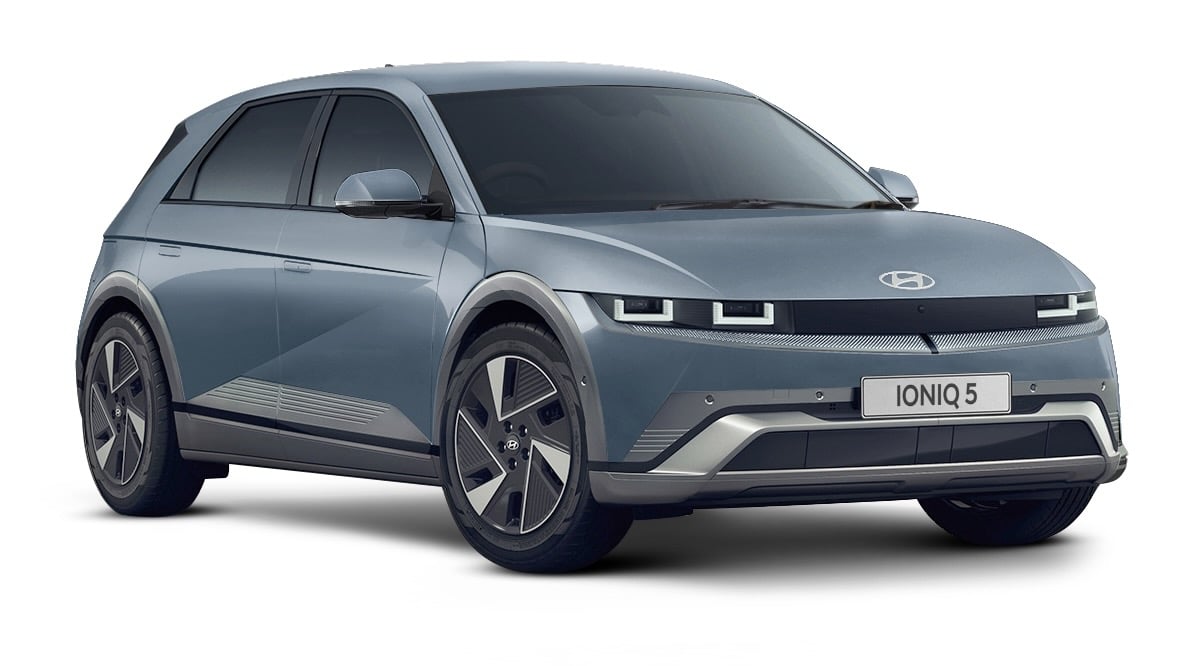
Hyundai Australia has significantly reduced the line-up of the 2026 IONIQ 5 – instead of the former 13 variants on offer, there’s now just four. The base model – now called, simply, IONIQ 5 – is now equipped with the 84kWh battery already standard in higher-end models and as a result, its WLTP range has grown from 440km to 570km. A 168kW/350Nm rear-mounted motor is standard equipment, up from the previous entry car’s 125kW motor.
The mid-spec Dynamiq is now called the Elite and only available with the same 168kW drivetrain as the base car, though with more standard features such as 20-inch wheels that reduce its range to 530km (WLTP). Above the Elite is the N Line Premium, which replaces the former Epiq with the optional N Line Package. It uses a 239kW/605Nm dual-motor drivetrain and its claimed WLTP range is 495km. The 448kW N remains at the top of the range, now priced from $115,000 plus on-road costs.
The IONIQ 5 N has also picked up new standard features such as adaptive high beam, auto up-down functionality for all windows, haptic feedback for the steering wheel, more customisation for the N Drift Optimiser Pro system and the N Active Sound system has been updated as well.
2026 Hyundai IONIQ 5 pricing (plus on-road costs):
| IONIQ 5 | $76,200 (+$400 over previous cheapest model with the 84kWh battery) |
|---|---|
| Elite | $81,200 (+$400 over previous Dynamiq) |
| N Line Premium | $91,700 (+$400 over previous Epiq N Line) |
| N | $115,000 (+$2000 over previous N with panoramic roof option) |
2026 Hyundai IONIQ 5 standard features:
- 19-inch alloy wheels
- Automatic LED lighting
- Automatic rain-sensing wipers
- Keyless entry and push button start with key or phone key
- Heated/auto-folding mirrors
- Wool and leather upholstery
- Leather steering wheel
- 10-way electric driver’s seat
- Dual-zone automatic climate control with rear vents
- 12.3-inch touchscreen and digital driver’s display
- Satellite navigation
- Wireless Apple CarPlay and Android Auto
- Six-speaker sound system
- Wireless phone charger
- 4x USB-C charging ports
- Heat pump
- 7x airbags
- Autonomous emergency braking with car/pedestrian/cyclist/junction turning/crossing assistance
- Adaptive cruise control with stop and go functionality
- Lane keeping assistance with adaptive lane guidance
- Traffic sign recognition
- Evasive steering assist
- Auto high beam
- Driver attention monitoring
- Blind-spot monitoring with camera and braking
- Rear cross-traffic alert with braking
- Tyre pressure monitoring
- 360-degree camera
- Front and rear parking sensors
Elite model adds:
- 20-inch alloy wheels
- Rear privacy glass
- Electric tailgate
- Sliding centre console
- ‘Eco-processed’ leather upholstery
- Heated front seats
- 10-way electric front passenger seat
- Alloy pedals
- Luggage net
- Head-up display
- Eight-speaker Bose sound system
N Line Premium model adds:
- Dual-motor all-wheel drive
- Projector LED headlights with adaptive high beam
- Panoramic sunroof
- Memory seating
- Ventilated front seats
- Heated steering wheel and rear seats
- N Line styling with bodykit, 20-inch wheels
- Suede and leather upholstery with red stitching
IONIQ 5 N model adds:
- N styling including 21-inch alloy wheels
- Three-mode suspension
- Multiple driving settings
- Uprated brakes
- Synthetic engine sound
- Revised centre console design
The updated 2026 Hyundai Ioniq 5 range will land in local Hyundai dealers soon.
Australian new vehicle sales in November 2025 have been released with the Toyota RAV4 topping the table as the best-selling vehicle in the country, along with an increase in plug-in hybrid numbers.
A total of 99,906 vehicles were registered in Australia in November 2025, which is 1.8 per cent less than November 2024, and there’s a strong chance that 2025 will set another sales record.
The RAV4 returned to the top of the sales chart with 6390 registrations – its second-best result on record – and it outsold both the Ford Ranger (4673) and Toyota HiLux (3418) utes, not for the first time. However, the RAV4’s 2025 total sales (45,909) still place it overall behind the Ranger (below) (51,125) and HiLux sibling (48,675).
In fourth place was the Chery Tiggo 4 small SUV (2287 sales, +207%) and fifth place was the Tesla Model Y (2269 sales, +37.3%), while the rest of the top 10 consisted of the Isuzu D-Max (2119), Ford Everest (2097), Hyundai Kona (2008), Mitsubishi Outlander (2006) and Hyundai Tucson (1942).
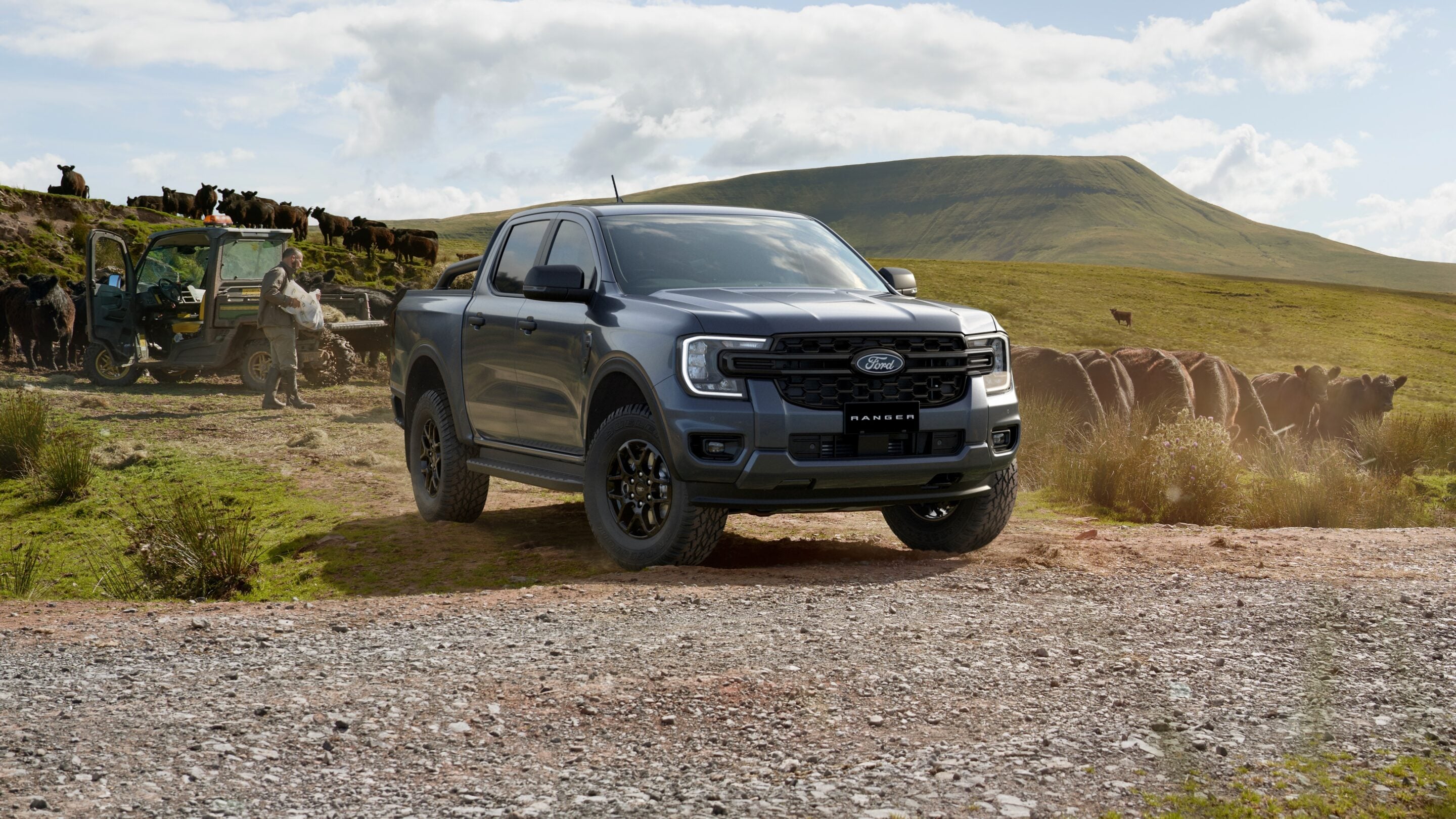
A big stand-out from November’s sales results was the performance plug-in hybrids, which reached 4783 sales (+83.3 per cent) for the month. PHEV sales have surged 130.6 per cent to 47,565 units as more models enter the market. Petrol vehicles continued their downward trajectory, with overall petrol sales falling 18.1 per cent in November and 9.5 per cent year to date.
Federal Chamber of Automotive Industries chief executive Tony Weber said the results point to a sustained shift in buyer priorities. “Plug-in hybrids continue to gain momentum because they give drivers the benefit of electric travel for daily use while removing range concerns. Consumers are looking for flexible, low-emission choices and brands are meeting that demand,” Mr Weber said.
Top 10 best-selling models in Australia November 2025:
- Toyota RAV4: 6390 (+15.6%)
- Ford Ranger: 4673 (-6.2%)
- Toyota HiLux: 3418 (-4.3%)
- Chery Tiggo 4: 2287 (+207%)
- Tesla Model Y: 2269 (+37.3%)
- Isuzu D-Max: 2119 (-2.8%)
- Ford Everest: 2097 (-23.4%)
- Hyundai Kona: 2008 (+57%)
- Mitsubishi Outlander: 2006 (-18.9%)
- Hyundai Tucson: 1942 (+25.9%)
Top 10 best-selling brands in Australia November 2025:
- Toyota: 19,787 (-3.8%)
- Ford: 7407 (-15.1%)
- Mazda: 6979 (-8.0%)
- Hyundai: 6707 (+19.6%)
- Kia: 6510 (+1.6%)
- Mitsubishi: 4414 (-28.9%)
- GWM: 4160 (+16.7%)
- BYD: 3790 (+144.2%)
- Isuzu Ute: 3721 (+9.9%)
- Chery: 3617 (+105.3%)
State/Territory results November 2025:
- Australian Capital Territory: 1302 (-2.3%)
- New South Wales: 30,062 (-1.4%)
- Northern Territory: 670 (-7.8%)
- Queensland: 20,572 (-3.5%)
- South Australia: 6096 (-7.5%)
- Tasmania: 1883 (+14.7%)
- Victoria: 25,995 (-2.7%)
- Western Australia: 10,457 (+1.9%)
Data complied via the Federal Chamber of Automotive Industries (FCAI) and Electric Vehicle Council (EVC).
New cars, utes and SUVs sold in Australia will have to adhere to strict new tailpipe emissions laws, catching up to markets like Europe.
As of December 1, 2025, all new vehicles complied must be engineered to comply with the new Euro 6d standard, while new vehicles already sold locally have until July 2028. Euro 6s different to the NVES scheme, which targets carbon dioxide instead.
The new standards dictate significantly lower nitrogen oxides such as carbon monoxide, hydrocarbons, oxides of nitrogen and particulate matter from both petrol and diesel vehicles, while all diesel vehicles will be required to fit a diesel particulate filter (DPF) as standard – and some may need AdBlue as well.
According to the government, Euro 6d will deliver the following benefits relative to current (Euro 5 equivalent) ADR for light vehicle emissions:
- a 55 per cent reduction in the emissions limits for oxides of nitrogen (NOx) for diesel vehicles
- the introduction of a limit on the number of particles to control fine particle emissions from petrol vehicles with direct injection fuelling systems
- more stringent requirements for on-board diagnostic systems that monitor the emissions control systems
- improved emissions tests (laboratory and on-road) to ensure reductions in emissions are also realised during normal operation on the road.
Euro 6d will hit diesel vehicles hardest as their nitrogen oxide levels will be required to be slashed from 180 milligrams per kilometre (mg/km) to 80mg/km in passenger vehicles and from 280mg/km to 125mg/km in light commercial vehicles.

But while Euro 6d will ensure cleaner vehicles are sold in Australia, it also targets the fuels sold here. As of December 15, 2025, all fuel will need to adhere to a standard of 10ppm (parts per million) of sulphur content. That’s five times less than current 95 and 98RON premium unleadeds on sale, and 15 times less than current 91RON regular unleaded. The 150ppm sulphur limit makes Australia’s current 91RON fuel the dirtiest in the developed world.
Already, 10ppm diesel has been sold in Australia since 2009 as part of the Fuel Quality Standards Act 2000, while 10ppm petrol is already sold in markets such as Europe, China and even our closest neighbour: New Zealand.
In addition, 95 RON premium unleaded petrol specifically will need to have reduced levels of aromatic hydrocarbons, and a small price rise of 0.9c per litre is expected – but vehicles using the fuel will be more efficient as a result.

Aside from the environmental benefits, the government is touting increased health benefits for the population, stating on its website: “The new laws for light vehicle noxious emissions are expected to reduce the burden of disease attributable to noxious emissions from cars, sport utility vehicles and light commercial vehicles (vans and utes) by $4.6 billion over the period to 2040. These benefits will increase over time as older vehicles are replaced with newer, cleaner vehicles.”
You can read more about the Euro 6d emissions laws at the government’s website here.
New research has revealed the most expensive toll roads in Australia, with prices reaching up to $13.50 per kilometre and rising faster than inflation on one Melbourne thoroughfare. That’s according to car insurance comparison website iSelect, which has analysed the cost of toll roads in Australia. The study has revealed which tolls are the most expensive, which roads generate the highest revenue, how prices have changed over time, and which areas face the priciest journeys.
iSelect has named Melbourne’s CityLink as Australia’s most expensive toll road. The 22km freeway from the city’s north-west to south-east, going over Bolte Bridge and underneath the Melbourne CBD, the CityLink can cost drivers up to $12.25 per trip.
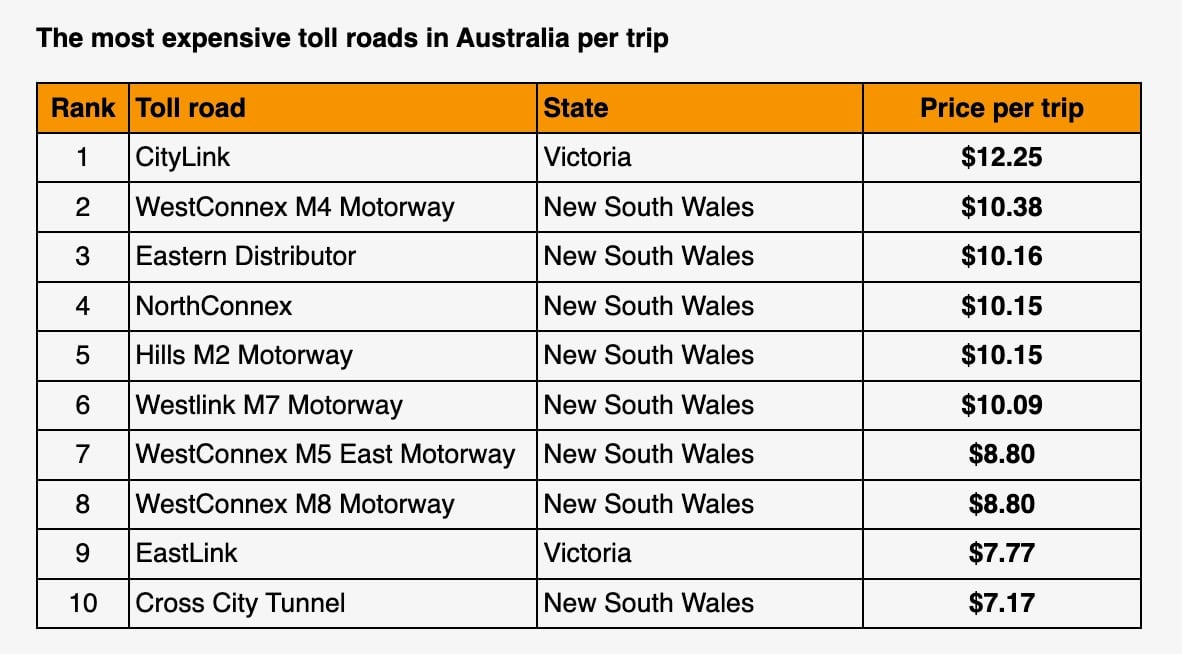
But according to iSelect, drivers in Sydney are hit the hardest with tolls because eight of the top 10 of Australia’s most expensive toll roads are in the city. That includes the WestConnex M4 ($10.38), Eastern Distributor ($10.16) and NorthConnex ($10.15).
Assessed on expense per kilometre, it’s another city that tops the list with Brisbane’s Go Between Bridge revealed as Australia’s most expensive toll road at $13.50/kilometre. For a toll road that’s only 300 metres long, its short distance makes it far less cost-efficient than any other toll road in the country.
Runner-up in the per kilometre expense contest include the Military Road ramp in Sydney ($10.35/kilometre), followed by the Sydney Harbour Bridge during peak hours ($4.41 per kilometre) and the Cross City Tunnel in Sydney ($3.41 per km). Using the Sydney Harbour Bridge is better value in off-peak times at $2.40 per kilometre.
According to iSelect, Sydney’s other tunnels are much better value for money as they’re longer. The Eastern Distributor ($1.69/km), NorthConnex ($1.13/km) and Lane Cove Tunnel ($1.09/km), show that distance brings better value, even when total tolls exceed $10.
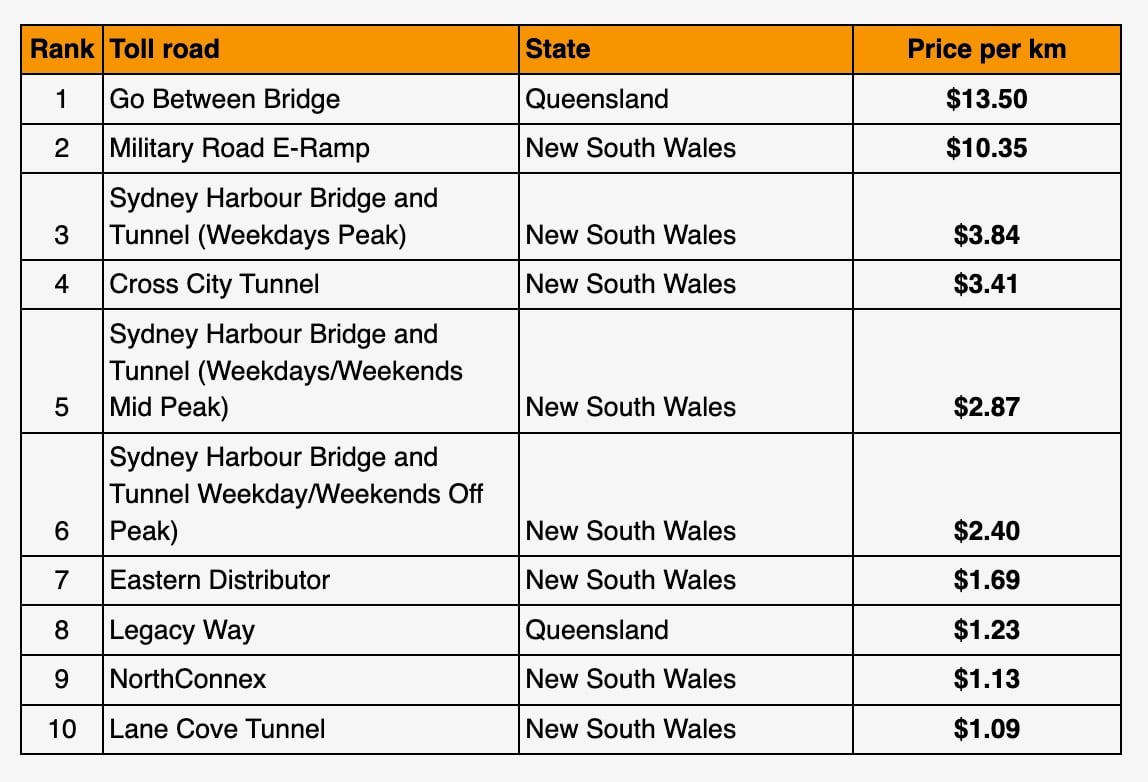
Other interesting insights from iSelect’s survey included that Sydney’s WestConnex is the highest-earning toll road in Australia and estimated to earn $1.88billion in revenue for the 2025 financial year.
The WestConnex M4 has also recorded the fastest year-on-year toll rise in Australia, increasing by an average of 12.3 per cent since 2015. Prices have increased from $4.56 in 2017 to $10.38 in 2025, according to iSelect, and all toll price rises except for the Sydney Harbour Bridge rose faster than inflation. Queensland’s Legacy Way Tunnel followed the Sydney Harbour Bridge with an average annual increase of 6.3 per cent, rising from $3.90 in 2015 to $7.00 in 2025.
Victoria’s CityLink ranks second for the highest-earning toll roads, earning an estimated $987 million, reflecting its high cost and popular use. Overall, toll company Transurban dominates the Australian toll landscape, holding full and partial ownership of every top-earning toll road, which explains why the company earned a profit of $178 million last financial year.
The full iSelect survey can be viewed here.
Ford has announced that the Ranger Super Duty, which will now arrive in Australia ahead of schedule before the end of 2025, will gain extra variants by mid 2026 in a bid to add further appeal in the serious mid-size work truck range.
In addition to the single cab, super cab and double cab-chassis variants already announced for the Ranger Super Duty, Ford will add a double cab pick-up variant ($93,990 plus on-road costs), as well as a higher-spec XLT model available in double cab-chassis and double cab pick-up forms.
Priced from $95,990 +ORC, the Ranger Super Duty XLT is $6000 more expensive than the regular Super Duty but adds more creature comforts, including leather upholstery, electric front seat adjustment, heated and ventilated front seats, carpet flooring, all-weather floor mats and unique eight-stud 18-inch alloy wheels painted in a unique ‘Magnetite’ finish.
A new ‘Traction Green’ paint colour will also be made available across the Ranger Super Duty line-up.
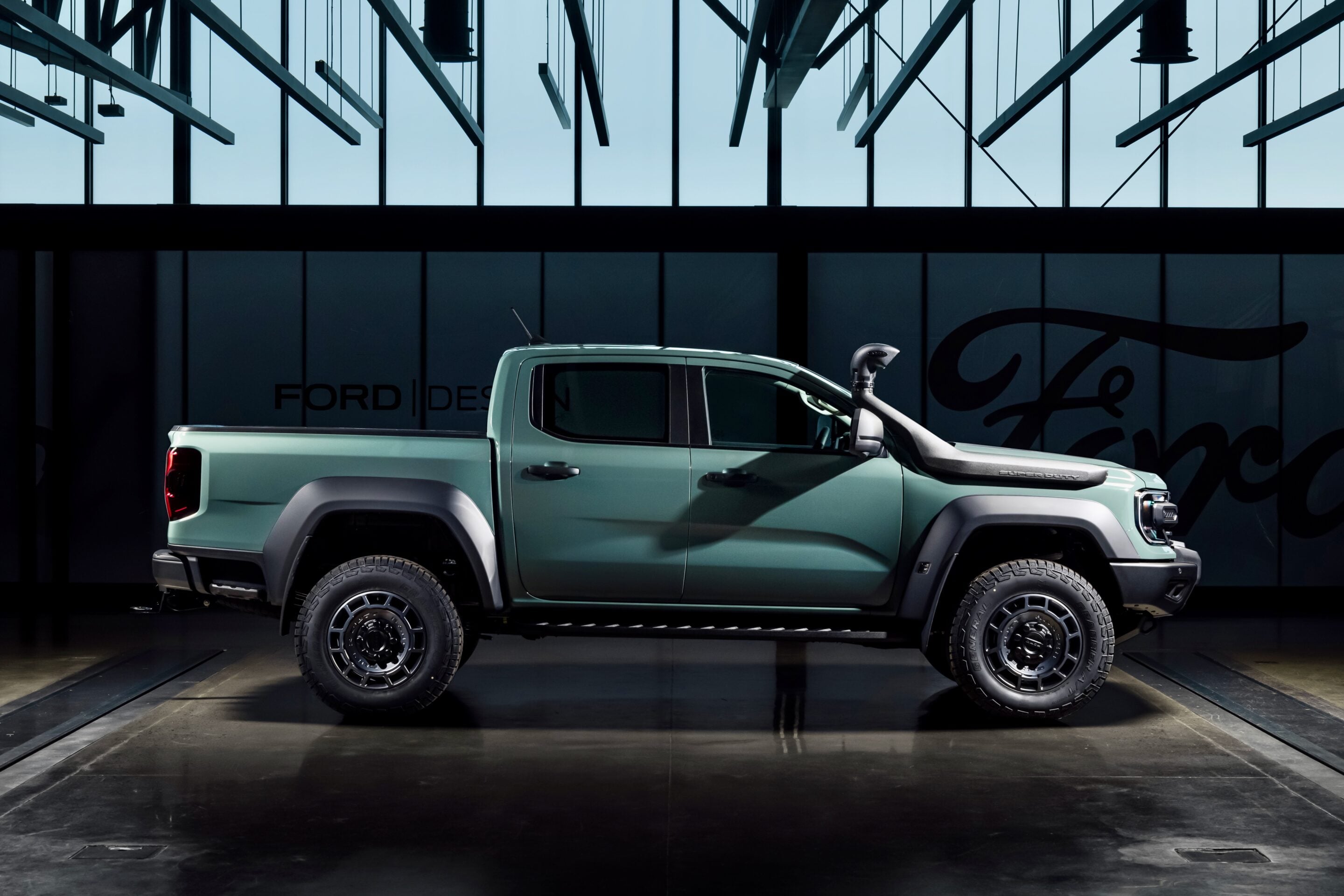
As a refresher, the Ford Ranger Super Duty was designed and engineered in Australia as a heavy duty variant of the Ranger ute. Thanks to its engineering enhancements, it’s rated to tow up to 4500kg, as well as having a 4500kg gross vehicle mass (GVM) and 8000kg gross combination mass (GCM) – big improvements on the Ranger XLT V6’s 3500kg, 3280kg and 6400kg respective ratings.
Changes to the Super Duty include eight-lug 18-inch wheels with 33-inch all-terrain tyres, raised suspension, a larger 130-litre fuel tank, a strengthened chassis to cope with extra loads and additional underbody protection.
All Ranger Super Duty variants will be powered by the same 3.0-litre turbocharged V6 diesel engine as the regular Ranger, making 154kW of power and 600Nm of torque.
2026 Ford Ranger Super Duty pricing (plus on-road costs):
| Single Cab-Chassis | $82,990 |
|---|---|
| Super Cab-Chassis | $86,490 |
| Double Cab-Chassis | $89,990 |
| Double Cab Pick-Up | $93,990 |
| XLT Double Cab-Chassis | $95,990 |
| XLT Double Cab Pick-Up | $99,990 |
The expanded Ford Ranger Super Duty line-up will go on sale by mid-2026, with full specifications to be announced before then.
Chinese EV newbie to Australian shores XPeng has announced three new models for our market in 2026.
Celebrating 2000+ sales here in 2025, XPeng, the new arrivals will begin with the updated G6 due in the first quarter. The G9 electric people mover will launch mid-year, while the G9L large SUV will land by year’s end.
Updated G6: late Q1 2026
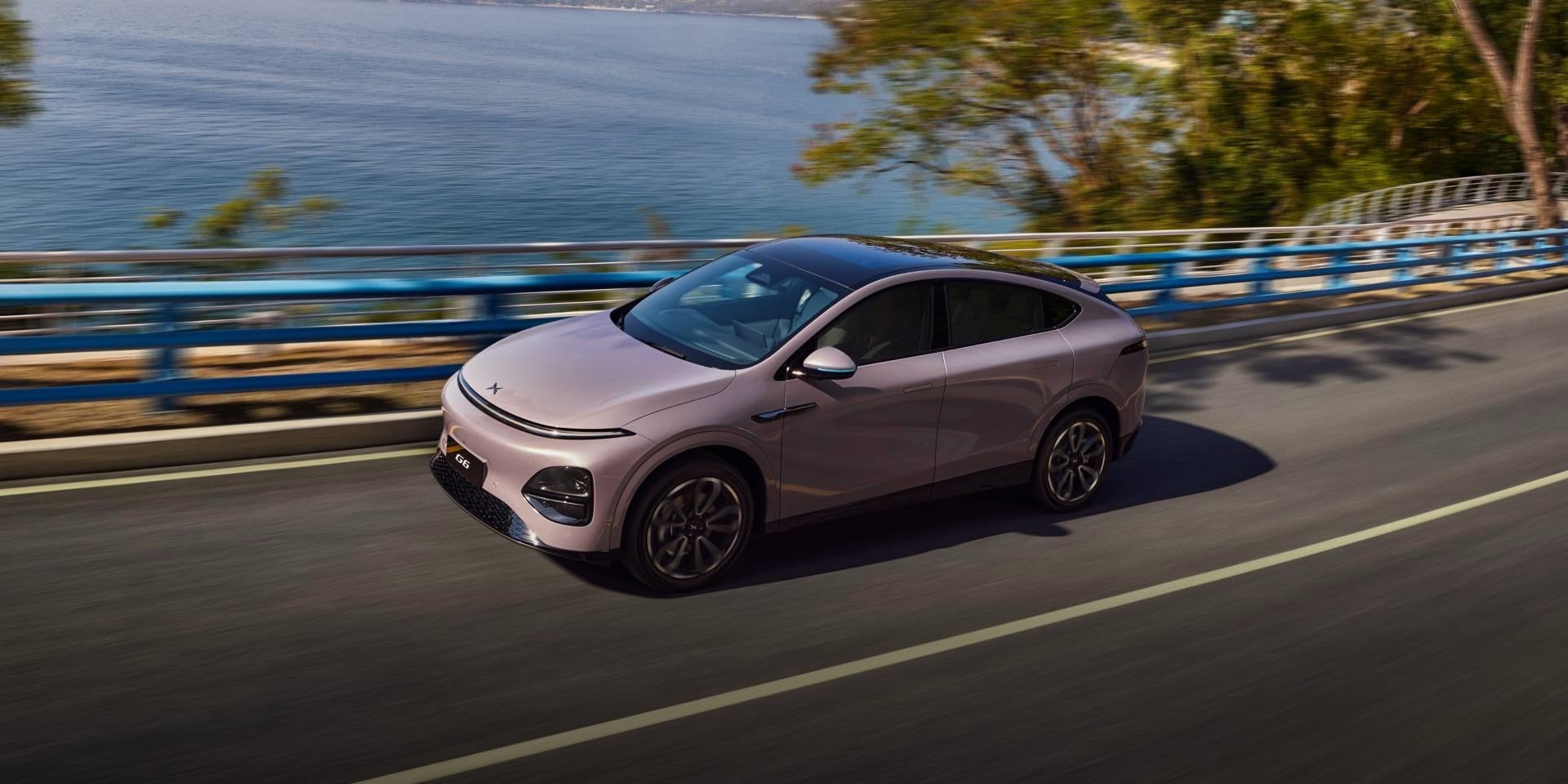
The G6 mid-size electric SUV is the first – and only – XPeng product available in Australia and its mid-life update is launching at the end of the first quarter of 2026. The revised model will feature refreshed exterior styling including new front and rear lighting units, and new alloy wheels.
Inside the updated G6, the touchscreen grows from 14.9-inches to 15.6-inches in size, while there is also a redesigned dashboard with new ambient lighting and new higher-quality materials.
The G6 Standard Range’s battery has grown from 66kWh to 68.5kWh, increasing its WLTP range from 435km to 470km. The G6 Long Range, however, is now fitted with a smaller battery in European markets. Its former 87.5kWh battery is now 80.8kWh, which has resulted in a 525km WLTP driving range rating (down from 570km) though at least power has increased from 210kW to 218kW.
A new Performance model has been added making 358kW/660Nm outputs and using the same 80.8kWh battery as the Long Range for a 510km WLTP rating. It hits 100km/h in just 4.1 seconds. Australian models and pricing is yet to be revealed.
X9 people mover: mid-2026
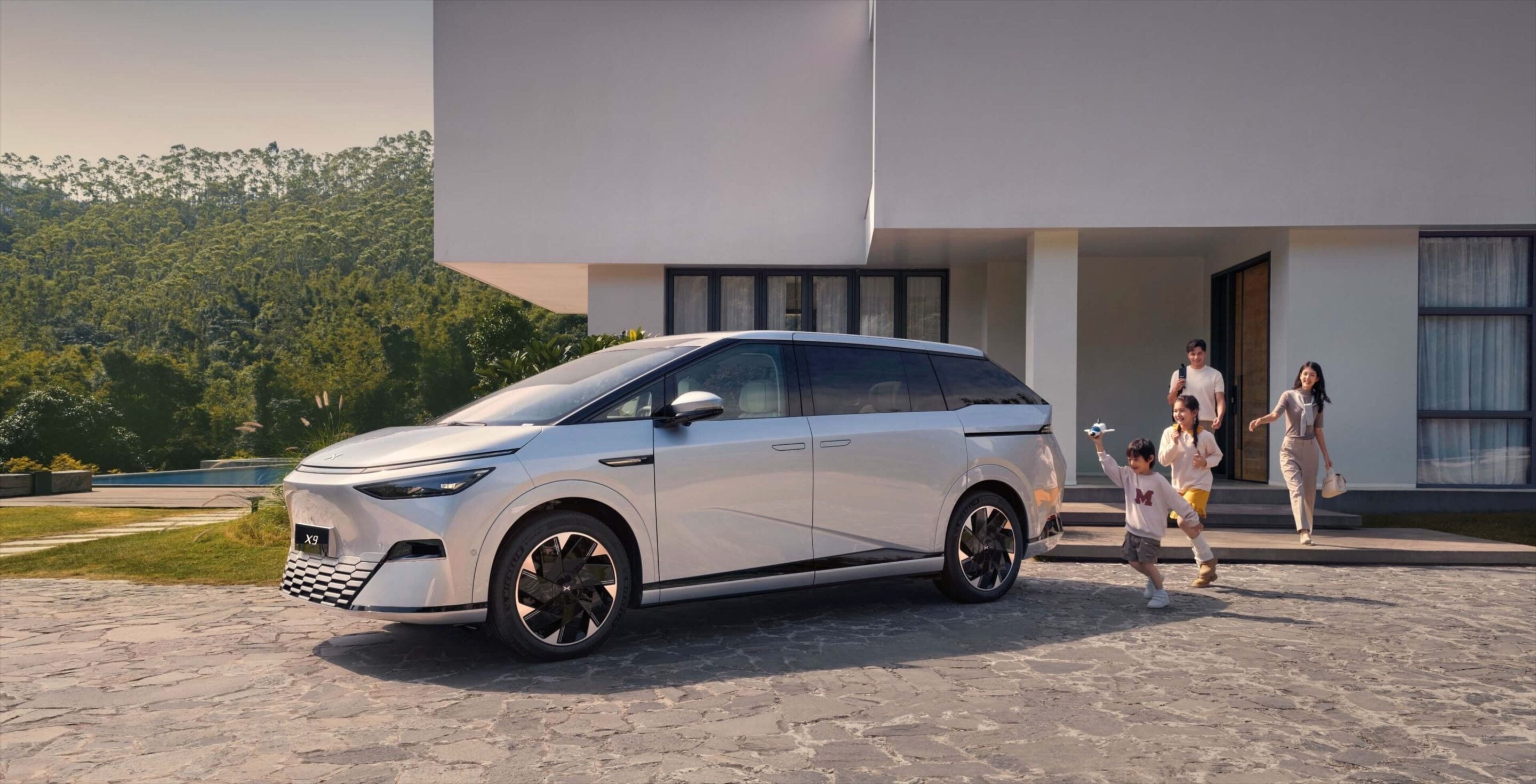
The second model in XPeng’s Australian expansion, the X9 people carrier, will arrive in mid-2026. Pricing is yet to be announced, but the X9 is a large seven-seat fully electric MPV that uses an 800-volt architecture and depending on market, 94.8kWh LFP or 105kWh NMC battery options for up to 702km of range on the lenient CLTC cycle (WLTP figures are yet to be confirmed).
Inside the X9 is a broadly similar dashboard layout to the G6 with a large touchscreen, freestanding driver’s display and a lot of soft touch materials around. The X9 offers seating for up to seven, with electrically adjustable captain’s chairs in the second row.
While features and specifications are yet to be announced, available features on the X9 include “zero gravity” front seats with 16-point massaging, auto-retracting second- and third-row seats, a 21.4-inch rear passenger screen and a 23-speaker Xopera sound system.
G9L: late 2026
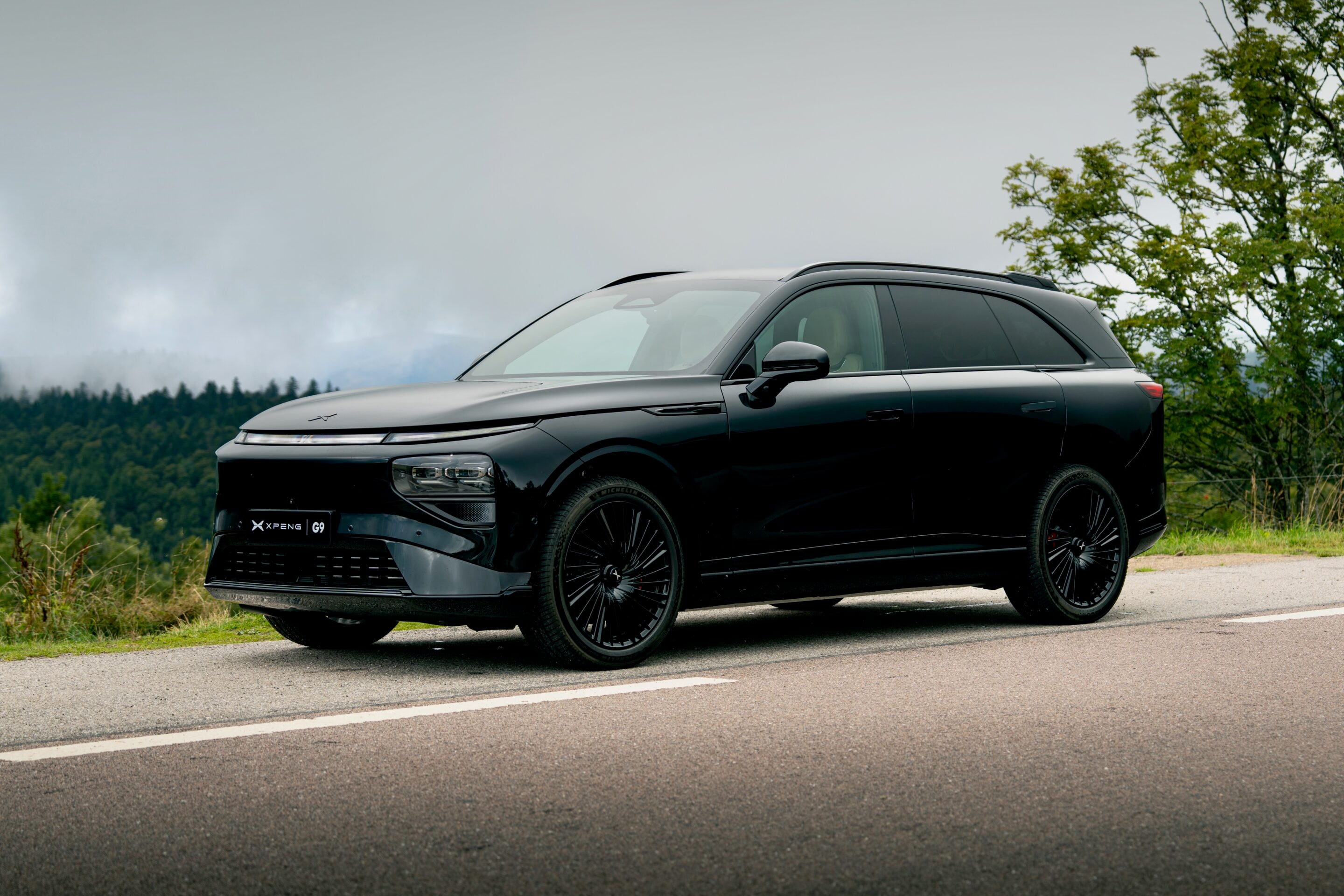
The final piece of XPeng’s 2026 puzzle will be the G9L large SUV, which will arrive in the final quarter of 2026. Measuring just under 5.0 metres long, the G9L will compete with cars such as the Toyota Kluger but is fully-electric.
Using the same 800-volt architecture as the X9, the G9L will offer a range of up to 570km (WLTP) from its 89kWh battery that can be recharged at up to 300kW for a 10-80 per cent charge in a claimed 20 minutes. All-wheel drive models produce up to 408kW of power and can hit 100km/h in just 4.2 seconds.
Features available on the G9L include air suspension, a 22-speaker Xopera sound system, external speakers to play music, soft-close doors, massaging front and rear seats and Nappa leather trim.
In addition to the three new models announced, XPeng’s local distributor also confirmed that XPeng has “two to three” new global models in development.
Australian pricing and specifications for the additions to the XPeng range will be confirmed in 2026.